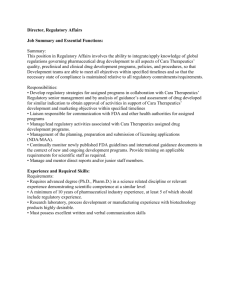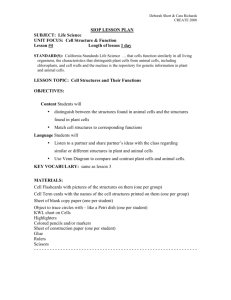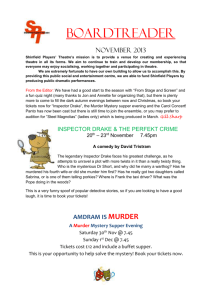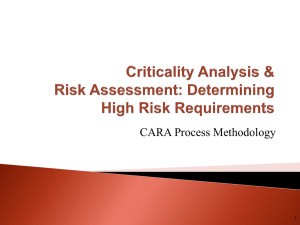ppt
advertisement
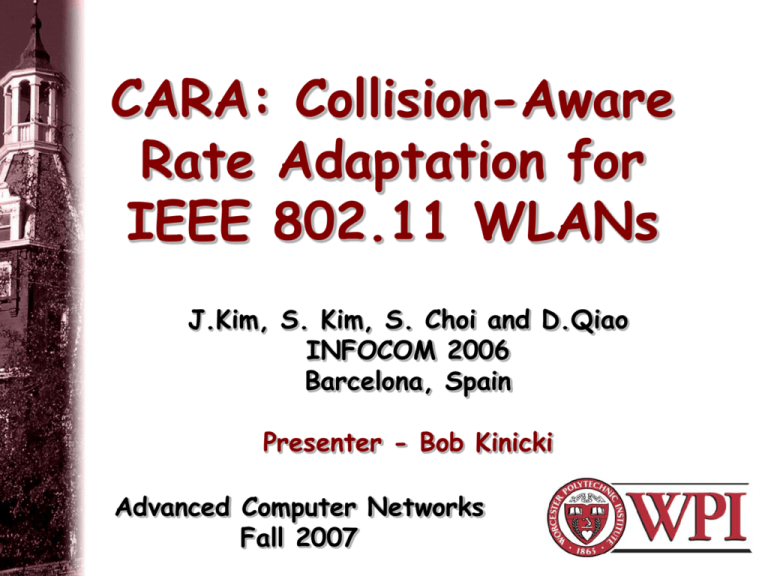
CARA: Collision-Aware
Rate Adaptation for
IEEE 802.11 WLANs
J.Kim, S. Kim, S. Choi and D.Qiao
INFOCOM 2006
Barcelona, Spain
Presenter - Bob Kinicki
Advanced Computer Networks
Fall 2007
Outline
• Background
• Related Work
– ARF
– RBAR
• CARA (Collision Aware Rate Adaptation)
– RTS Probing
– CCA Detection
• Simulated Performance Results
• Conclusions and Comments
2
Advanced Networks Fall 2007 - CARA
Infrastructure WLAN
client
Internet
Access
Point
client
3
client
client
Advanced Networks Fall 2007 - CARA
Basic CSMA/CA
possible
collision !!
[N. Kim]
4
Advanced Networks Fall 2007 - CARA
Physical Layer Overhead
[N. Kim]
5
Advanced Networks Fall 2007 - CARA
Node Contention
without RTS/CTS
[N. Kim]
6
Advanced Networks Fall 2007 - CARA
Rate Adaptation versus Distance
7
Advanced Networks Fall 2007 - CARA
Unfairness
[Choi]
8
Advanced Networks Fall 2007 - CARA
Multiple APs
multiple clients (heterogeneous)
client
client
client
client
Access
Point
Access
Point
client
client
9
client
Advanced Networks Fall 2007 - CARA
client
Hidden Terminals
Without a hidden terminal, loss ratio ~5.5%.
One hidden AP with mild sending rate
(0.379 Mbps) yields:
[Wong]
10
Advanced Networks Fall 2007 - CARA
RTS/CTS Summary
• RTS/CTS can reduce collisions.
• RTS/CTS can guard against and
reduce hidden terminals.
• RTS/CTS adds overhead that reduces
throughput.
• Normally, RTS/CTS is turned off!
11
Advanced Networks Fall 2007 - CARA
Rate Adaptation Algorithms
•
•
•
•
•
•
•
12
AARF
CARA
Fast-LA
LD-ARF
MPDU
PER
RRAA
ARF
AMRR
CROAR
DOFRA
HRC
LA
MiSer
MultiRateRetry
OAR
ONOE
RBAR
RFT
SampleRate SwissRA
Advanced Networks Fall 2007 - CARA
Rate Adaptation Algorithms
1997 ARF
1998
1999
2000
2001 RBAR
2002 MPDU
2003 LA
2004 AARF
2005 Fast-LA
2006 CARA
2007
13
OAR
MiSer
AMRR
LD-ARF
CROAR
PER
SwissRA
HRC
MultiRateRetry
RFT
SampleRate
DOFRA RRAA
Advanced Networks Fall 2007 - CARA
Rate Adaptation Algorithms
Uses recent history and probes: ARF, AARF,
SampleRate
Long interval smoothing: ONOE, SampleRate
Multiple rates: MultiRateRetry, AMRR, RRAA
Uses RTS/CTS: RBAR, OAR, CROAR, CARA
Uses RSSI to approximate SNR, each node maintains
12 dynamic RSS thresholds: LA
Puts checksum on header and use NACK to signal link
loss error: LD-ARF
Table lookup with thresholds:
HRC,MPDU(len,rSNR,count)
Fragmentation: DOFRA, RFT
Miscellaneous: PER, MiSer, SwissRA, Fast-LA
14
Advanced Networks Fall 2007 - CARA
ARF Algorithm
• If two consecutive ACK frames are not
received correctly, the second retry and
subsequent transmissions are done at a
lower rate and a timer is started.
• When the number of successfully received
ACKs reaches 10 or the timer goes off, a
probe frame is sent at the next higher rate.
However, if an ACK is NOT received for this
frame, the rate is lowered back and the timer
is restarted.
15
Advanced Networks Fall 2007 - CARA
ARF and AARF
16
Advanced Networks Fall 2007 - CARA
RBAR Algorithm
• {not 802.11 compatible}
• Receivers control sender’s transmission
rate.
• RTS and CTS are modified to contain info on
size and rate.
• Uses analysis of RTS reception (RSSI?) to
estimate SNR and send choice back to
sender in CTS.
• Receiver picks rate based on apriori SNR
thresholds.
17
Advanced Networks Fall 2007 - CARA
Collision Aware Rate
Adaptation (CARA)
• Employs two methods for identifying
collisions:
1. RTS Probing
2. Clear Channel Assessment (CCA)
• Focuses on when to decrease the
transmission rate.
Set Mth , the consecutive increase
threshold, to the same value as ARF:
Mth = 10.
18
Advanced Networks Fall 2007 - CARA
CARA RTS Probing
• Assumes all RTS transmission failures are
due to collisions.
• Transmission failure after RTS/CTS must
be due to channel errors.
• RTS probing that enables an RTS/CTS
exchange ONLY when a data frame
transmission fails.
19
Advanced Networks Fall 2007 - CARA
RTS Probing State Diagram
20
Advanced Networks Fall 2007 - CARA
RTS Probing
21
Advanced Networks Fall 2007 - CARA
RTS Probing
CARA default: [Pth = 1, Nth = 2]
• Data frame transmitted without
RTS/CTS.
• If the transmission fails, RTS/CTS
exchange is activated for the next
retransmission. If this retransmission
fails, then the rate is lowered.
• If retransmission is successful, stay at
same rate and send next frame without
RTS/CTS.
22
Advanced Networks Fall 2007 - CARA
ARF vs RTS Probing
t1 < t 2
23
Advanced Networks Fall 2007 - CARA
Clear Channel Assessment (CCA)
• At SIFS time after wireless transmission
finishes, assess channel with CCA.
• Since ACK expected to start at SIFS, if
channel assessed as busy (i.e. not an ACK)
then assume it is a collision.
• In this case [Case 2], retransmit without
increasing the failure count and without
lowering the transmission rate.
• CCA does not help for Case 1 or Case 3.
Hence RTS Probing is launched.
24
Advanced Networks Fall 2007 - CARA
CCA Detection
This assumes no hidden terminals!
25
Advanced Networks Fall 2007 - CARA
Performance Evaluation
using ns-2 simulator
Simulation Setup:
• 802.11b with Frame Error Rate
• Ricean multi-path fading model
• Traffic is ‘greedy’ 1500 octet UDP packets
• CARA-1 :: only RTS Probing
• CARA-2 :: RTS Probing + CCA
• AWGN (additive white Gaussian noise) model::
– the only impairment is the linear addition of wideband or
white noise with a constant spectral density (expressed as
watts per hertz of bandwidth) and a Gaussian distribution of
amplitude. {Wikipedia}
26
Advanced Networks Fall 2007 - CARA
One-to-One Topology
No collisions !!
27
Advanced Networks Fall 2007 - CARA
Star Topology Simulations
• Vary the number of contending stations
evenly spaced on a circle with 10 m
radius around the AP.
• AWGN wireless channel assumed.
• Note – from Figure 6, stations should
be able to transmit at 11 Mbps at 10 m
without being significantly effected by
environment.
28
Advanced Networks Fall 2007 - CARA
CARA-1 (with RTS Probing)
Contention is harmful to
ARF without RTS/CTS
** partially due to
performance anomaly [14]
29
Advanced Networks Fall 2007 - CARA
Line Topology Simulations
• Assume a line topology with the AP at one
end.
• Contending stations select data frame size
randomly for each frame.
• Maximum distance between station and AP
set to 70 meters to guarantee no hidden
terminals.
• AWGN wireless channel assumed.
• Results in Figure 8 are averaged over 50
simulations.
30
Advanced Networks Fall 2007 - CARA
CARA-2 (with CCA)
31
Advanced Networks Fall 2007 - CARA
Random Topologies
• Nodes randomly placed within circle with
40 m radius centered on AP.
• Ricean K factor of 3 dB used to model indoor
environment.
Two simulation sets:
1. 50 distinct scenarios each with 10
randomly placed contending stations.
2. Vary the number of contending stations (5
to 20) and average results over 50 random
topologies for each number of stations.
32
Advanced Networks Fall 2007 - CARA
10 Random Stations
With Ricean fading,
CARA-2 is not always better!
33
Advanced Networks Fall 2007 - CARA
Varying Number of Stations
34
Advanced Networks Fall 2007 - CARA
Adaptability Comparison
35
Advanced Networks Fall 2007 - CARA
Transmission Counts
36
Advanced Networks Fall 2007 - CARA
Conclusions
• Two versions of CARA are proposed an
evaluated using ns-2 simulation.
• The simulations show that CARA
outperforms ARF in a variety of
environments and scenarios.
• CARA uses RTS Probing and CCA to
differentiate collisions from
transmission failures due to channel
errors.
37
Advanced Networks Fall 2007 - CARA
Comments
• Authors did not look at modifying the algorithm to
increase the data rate.
• Authors assumed hidden terminals were not
possible and simulations were designed to avoid
encountering this problem.
– Note, RRAA warns of RTS oscillation with hidden
terminals.
• Authors plan to implement CARA in the future using
MADWIFI.
38
Advanced Networks Fall 2007 - CARA
Thank You !!
CARA
Questions
and/or
Comments
